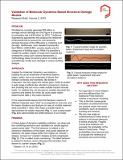| dc.contributor.author | Keremidis, Kostas | |
| dc.contributor.author | Pellenq, Roland | |
| dc.date.accessioned | 2021-03-02T15:03:50Z | |
| dc.date.available | 2021-03-02T15:03:50Z | |
| dc.date.issued | 2019-03 | |
| dc.identifier.uri | https://hdl.handle.net/1721.1/130033 | |
| dc.description.abstract | Windstorms currently generate $28 billion in average annual damage and this figure is projected to potentially rise to $38 billion by 2075. Traditional engineering approaches that analyze the resilience of structures fail to account for non-structural damage because of the difficulties in modeling such damage. Additionally, even detailed frameworks, like FEMA’s HAZUS-MH, provide results only for categories of building types. While it is possible to model the sudden impact of loads from hazards like windstorms using such existing frameworks, a methodology does not exist by which to readily and quantitatively model such damage to unique building designs. | en_US |
| dc.relation.ispartofseries | MIT CSHub Research Brief; Volume 2019, Issue 2 | en_US |
| dc.subject | Resilience | en_US |
| dc.subject | Structural Mechanics | en_US |
| dc.subject | Structural Engineering | en_US |
| dc.subject | Climate Change | en_US |
| dc.title | Research Brief: Validation of Molecular Dynamics-Based Structural Damage | en_US |
